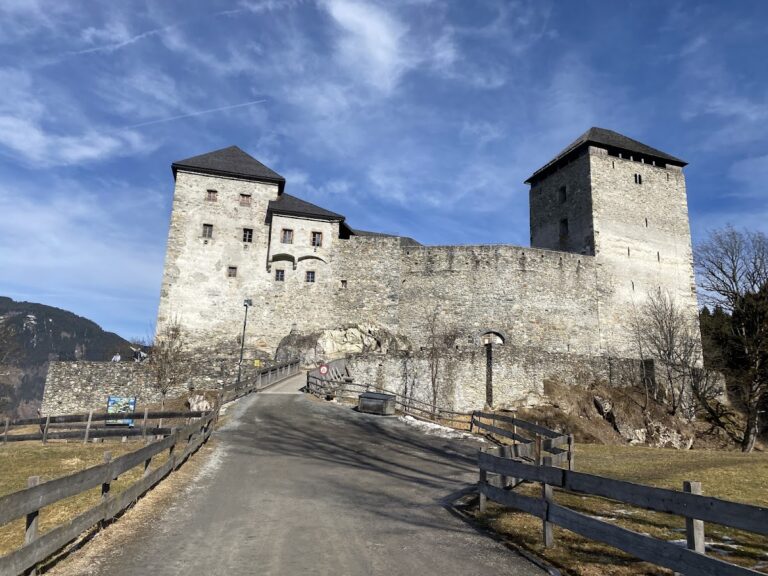Burgruine Taxenbach: A Medieval Fortress in Taxenbach, Austria
Visitor Information
Google Rating: 3.9
Popularity: Very Low
Google Maps: View on Google Maps
Country: Austria
Civilization: Unclassified
Remains: Military
History
Burgruine Taxenbach stands in the municipality of Taxenbach, Austria, and was built during the early 14th century by the Archbishops of Salzburg. Its origins lie in the aftermath of regional conflicts that reshaped local power structures during that period.
In the early 1300s, the earlier Edtburg castle near this area was destroyed amid the German throne dispute culminating in the Battle of Mühldorf. Following these upheavals, Archbishop Friedrich III von Leibnitz acquired the Taxenbach estate in 1323 and soon after constructed a new fortress on the site called Dechantshofbühel. By 1325, this castle served as the center for the local Pfleggericht, an administrative court overseeing judicial and governance matters for the region.
Throughout the late Middle Ages, Burgruine Taxenbach functioned as the seat for the court’s chancellor, officials, and prison. However, during the Peasants’ War of 1525-26, the castle suffered burning and damage inflicted by revolting peasants. Restoration efforts were undertaken by 1564, with authorities compelling peasants through forced labor to contribute to the archdiocese’s rebuilding costs.
An earthquake in 1673 caused notable structural damage to the castle, leading to extensive repairs that extended over the late 17th century. These included not only fortification work but also enhancements such as window glazing and the care of wall frescoes, ensuring the building remained functional. The castle continued as the seat of the local court until 1768, when its administrative functions were transferred to a new facility known as the Fronveste.
During the turbulent times of the Napoleonic Wars, control over Taxenbach changed hands, eventually bringing it under Bavarian authority. In 1812, the Bavarian royal finance chamber sold the castle and its lands at auction, with ownership passing into private hands under Johann Rathgeb. By the 1870s, the fortress had fallen into considerable disrepair and was inhabited by tenants. In November 1872, a fire caused by carelessness destroyed much of the remaining structure, after which it was never restored as a fortress.
Subsequent decades saw the castle’s stones being repurposed for local construction projects, including the 1938 expansion of the village schoolhouse. In 1962, modern houses were built atop the old castle foundations. The municipality of Taxenbach took ownership of the ruins in 1991, and by 1993 the site gained protection as an official historic monument.
Remains
Burgruine Taxenbach was originally a hilltop fortress situated on the Schlossberg, a prominent elevation south of the Taxenbach market and near the Salzach River’s left bank. Its core structure likely consisted of a masonry tower surrounded by a defensive ring wall, enclosing a small inner courtyard. Below this primary enclosure lay a Meierhof, a type of farmstead connected to the castle’s operations.
The defensive walls of the fortress were substantial, with remnants reaching up to five meters in height. The eastern wall, facing the nearby Kitzlochklamm gorge, extended approximately fifteen meters, while both the northern and southern walls stretched around forty-six meters each. The western wall once measured nineteen meters but has since been dismantled or lost over time.
Within the castle complex were rooms designated for administrative use, housing officials linked to the local court as well as a prison. Water was supplied to the fortress, although by the late 1500s this system had fallen into complete ruin. A notable feature of the fortress was a secret exit leading toward the Salzach River, providing an escape or discreet access route. Additionally, an underground passage ran through the Dechantbühel hill toward the market area; this tunnel entrance remained visible in the ruins until at least 1930.
In the late seventeenth century, after repair efforts from earthquake damage, the castle’s windows were fitted with panes made from broken and small pieces of glass, a detail reflecting the period’s restoration limitations. A fresco depicting Archbishop Paris Lodron once adorned the gate facing the market square; by then, the image had faded and required conservation.
By the twentieth century, only fragments of the original ring wall survived above ground. These remnants have been cleared of vegetation and stabilized to prevent further deterioration. The ruins now lie within the eastern reaches of Taxenbach and have been integrated into the town’s layout since the mid-1990s, maintaining a tangible connection to the region’s medieval history.







